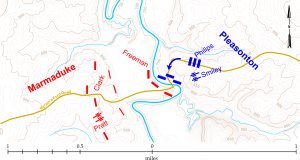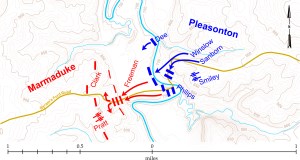Search:
Powered by
Website Baker
Tour Stop, “Freeman's Skirmish Line”
[Waypoint = 39.016633, -94.521721]
Directions
Leave Byram’s Ford and walk back up the Byram’s Ford Road. Just as you are leaving the trees and entering the open field, turn right (north) and follow the tree line for 50 feet or so until you find a place where you can look back down to the river. Look for another of those temporary signs on a thin, orange fiberglass pole.
Description
|
Map of initial Freeman's Skirmish Line by theCivilWarMuse based on USGS 1935 Kansas City Quadrangle (Click map for larger image) |
You are standing near where a Confederate skirmisher from Freeman’s Brigade stood waiting in the pre-dawn hour on that cold October 23 morning. If you look carefully, you should be able to see across the river to the spot where the Byram’s Ford Road approached the river. All along the west side of the river, Major General John S. Marmaduke deployed skirmishers as his first line of defense against the Federal advance down the Byram’s Ford Road. The Confederates took advantage of the abatis constructed by the Federals in the days leading up to the first fight for Byram’s Ford on October 22.
|
Map of withdrawal by Freeman's skirmishers at Byram's Ford on October 23, 1864 by theCivilWarMuse based on USGS 1935 Kansas City Quadrangle (Click map for larger image) |
Place yourself back on that bitterly cold morning. You probably have a muzzle-loading, single shot, Enfield rifle-musket. It’s cold and damp with a foggy haze clinging to the trees along the river. As the morning progresses, you begin to hear sounds across the river. Peering through the fog, you are able to make out the enemy moving towards the far bank of the river. Now Pratt’s artillery located on the hill several hundred yards to your rear begins to shell the far side of the river. The enemy artillery answers in kind. You hunker down, reminding yourself to aim low. Just when the enemy gets within musket range, you and your comrades let loose with a volley of musket fire. This continues until the enemy stops their advances and pulls back to regroup. You have been successful and stopped their first attack.
Sometime later, the enemy makes another advance towards the river. You can see them better because the morning fog is beginning to disappear. Just as you are getting ready to send another volley towards the hated Federals, you hear rapid musket firing over to the left. The Federals must have gotten across the river somehow and are attacking the left flank. You hear the sergeant yelling to fall back to the main defense line. You begin running double-quick, stopping only long enough to fire your musket at the Federals.
They’ve gotten across the river. Now the men from Clark’s brigade begin firing their muskets at the enemy. Pratt’s artillery adjusts their aim and shells the enemy positions on the west side of the river. The Federals have gotten to the west side of river, but are stopped by withering Confederate fire.
|
Sterling Price courtesy of the Library of Congress |
Historical Vignettes
Colonel Thomas R. Freeman, commanding Freeman’s Brigade in Marmaduke’s Division, wrote about the fighting at Byram’s Ford in his memoirs.
"Clark and I were summoned to meet with General Marmaduke where I received orders for the following day’s action. He directed me to hold Byram’s Ford for as long as possible. My effective strength at that point was less than 700 men. To aide in my defense of the ford I was given [Colton] Greene’s regiment under Captain [Benjamin S.] Johnson, after Col. Greene, who had been injured two days before at Little Blue was being treated, and Lt. Col. [W. J.] Preston, commanding Burbridge’s regiment. Together I had about 1300 men. Enough to give a good account. Marmaduke knew that we could not hold the position long and urged me to not involve myself into a heavy fight.
"Soon after sunrise on the morning of the 23rd, the sun was breaking above the tree line to the east when the enemy began their attacks. Just before sunrise I had posted Captain Johnson and his regiment on my right to face the east and south covering a bad portion of the front. He had advantage of height but lacked proper cover. To cover him I placed Col. Preston. Our object was to force the enemy to deploy and mount a heavy attack. I knew I could repulse his several attempts but once he gained advantage of my right and brought his guns to bear that it would be time to withdraw. That is precisely what happened. We repulsed their early attempts to cross the Big Blue but once they gained advantage of my right I had Preston cover while we pulled out of line. By 10 a.m. we had gained Clark’s lines whereupon I was directed to escort the wagons south to the Santa Fe line road. For the remainder of the day we were engaged in little skirmishing as the enemy attempted to gain our flanks and cut our line of advance south."
Brigadier General John B. Clark, Jr. deployed his brigade further west and had a good view of the skirmishers from Freeman’s Brigade.
"Freeman's brigade, met him first, my brigade being formed in his rear 500 yards. He contended manfully for the crossing of the Big Blue, but was forced back after having repulsed the enemy several times."
Major Abial R. Pierce, commanding Fourth Iowa Cavalry, wrote about his dismounted regiment running into heavy fire from the Confederate skirmish line.
"The enemy was well posted behind trees and fallen timber on the opposite bank, and poured in such a destructive fire that the [advance] halted."
Sergeant William F. Scott, Fourth Iowa Cavalry, remembered the Confederate skirmish line loosed volleys at the Federals as they advanced towards the Big Blue River.
"The enemy opened, from the bushes and felled trees on the opposite side of the river and from a higher position farther back, a hot fire of small-arms and artillery."
Captain Richard J. Hinton, commanding the Second Kansas Colored State Militia in the Army of the Border, described the initial Federal attack at Byram’s Ford.
"The enemy were posted in strong force on the west side of the stream; the ford and approaches being obstructed by Colonel [Charles] Jennison's defenses, materially strengthened by the rebels when they occupied his position. Their line was formed in force about a half mile from the stream. Bearing upon the ford, a heavy gun was planted, by which our line, as it formed and advanced was seriously annoyed, and quite a number killed and wounded.
"One battalion of the 4th Iowa Cavalry, under command of Captain [Edward W.] Dee, one hundred men of the 4th Missouri Cavalry, and the 7th M. S. M., commanded by Lieutenant-Colonel Crittenden, were dismounted and formed on the banks of the river. The firing opened sharp and effective. The 4th M. S. M., Major [George W.] Kelly commanding, and the 1st M. S. M. Cavalry, commanded by Lieutenant-Colonel [Bazel F.] Lazear, were formed in column, directed to cross and charge the enemy beyond the ford. This order was executed in the face of the galling rebel fire and despite the obstacles in the creek. A number of men and horses were killed and wounded in the stream. Nothing daunted, our troops resolutely pushed forward and gained the west bank … The rebel line was driven back for two hundred yards. They then occupied a range of low hills, extending through an open field to the left, and along a bluff covered with dense wood on our right. It was strengthened very much by high fences and some log buildings, behind which the rebels were posted."

